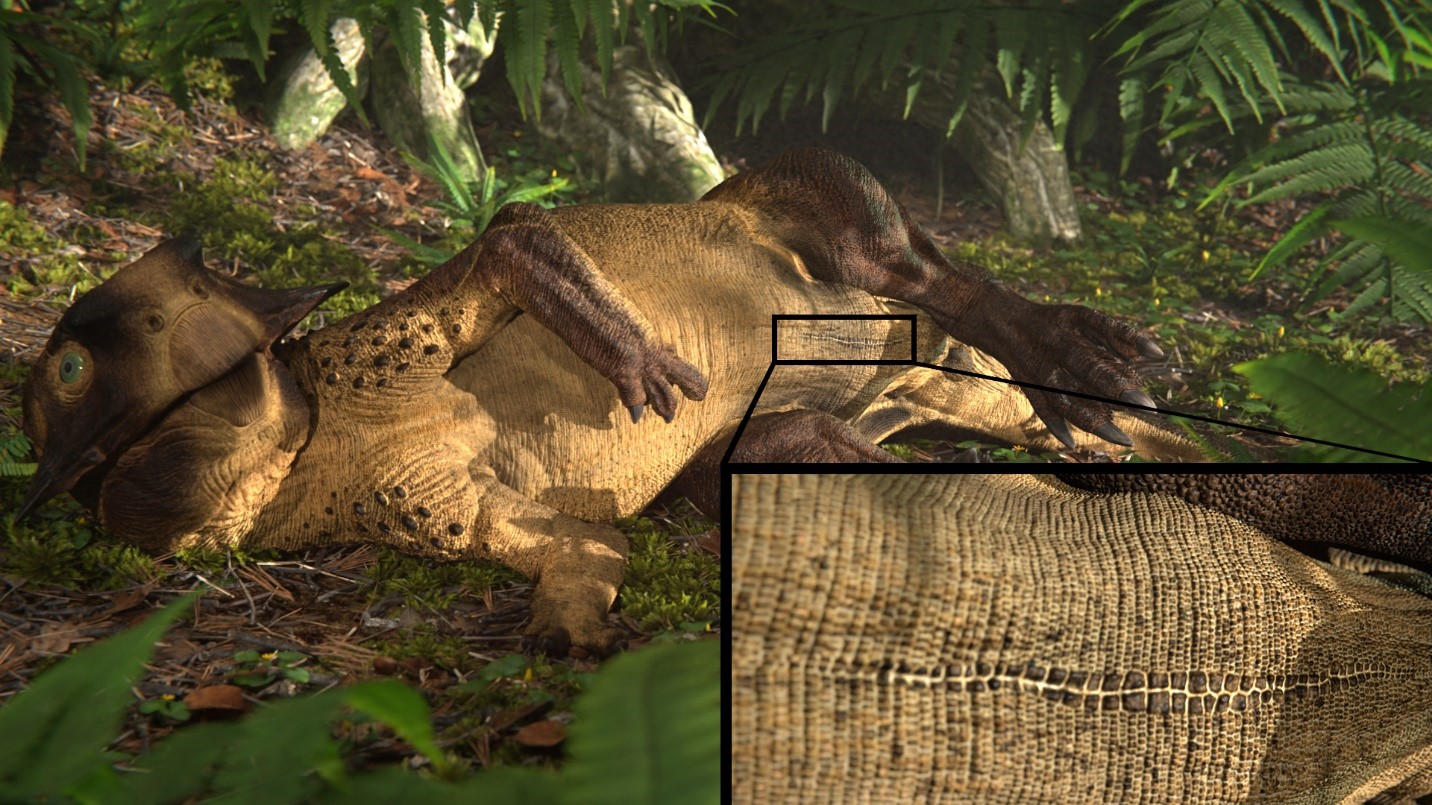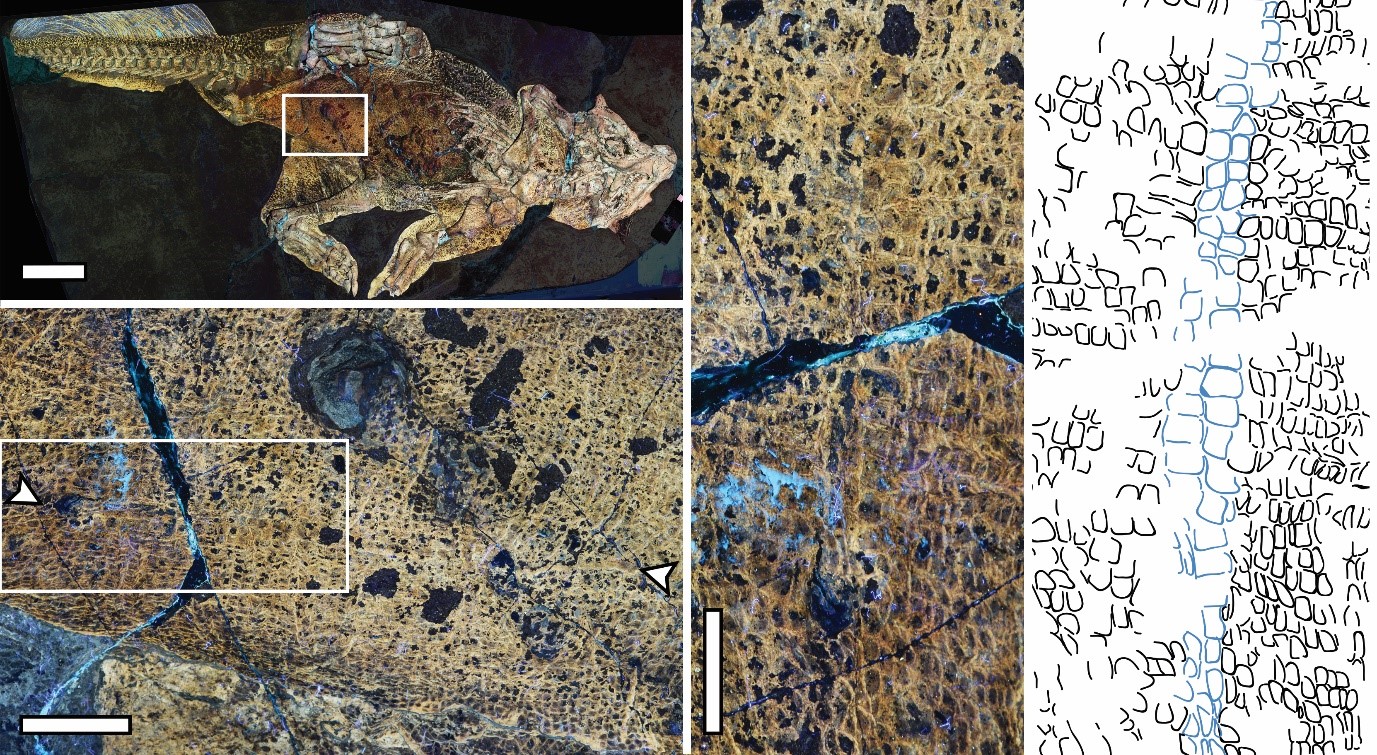Dino with 'perfect and unique' butthole also had the oldest belly button known to science
The navel scar was discovered using laser imagery.

Paleontologists have discovered the oldest belly button known to science — and the first ever found on a non-avian dinosaur — on a 125 million-year-old fossil of a parrot-beaked biped in China.
The faint navel mark belongs to a reptile in the genus Psittacosaurus, which lived during the Cretaceous period (145 million to 66 millions years ago). Scientists spotted the long, thin trace of an umbilical scar when they exposed the fossil to a concentrated beam of laser light. The scar is a slight misalignment in the pattern of skin and scales over the dinosaur's abdomen and is the reptile equivalent of a mammalian belly button.
Unlike fetal mammals, which get their nutrients from a placenta, the embryos of birds and reptiles are nourished by a yolk sac connected to their abdomens through various blood vessels. When these embryos hatch, the yolk sac is absorbed completely into the body, leaving a linear abdominal scar that usually heals in a few days or weeks. But in some reptiles, such as alligators, the umbilical scar can last beyond sexual maturity. This fossilized navel discovery is the first indication that dinosaurs may have also had umbilical scars that never completely disappeared. The researchers published their findings June 7 in the journal BMC Biology.
Related: How did 'Prehistoric Planet' create such incredible dinosaurs? Find out in a behind-the-scenes peek.
"This Psittacosaurus specimen is probably the most important fossil we have for studying dinosaur skin," vertebrate paleontologist Phil Bell, a senior lecturer in the School of Environmental and Rural Science at the University of New England in Armidale, Australia, said in a statement. "But it continues to yield surprises that we can bring to life with new technology like laser imaging."
The fossil, known as SMF R 4970, is a Psittacosaurus mongoliensis, an early type of ceratopsian, a group of beaked herbivores that later included Triceratops. Measuring 6 feet (1.8 meter) long and 4 feet (1.2 m) tall, P. mongoliensis was likely a highly social creature, living in groups and foraging for seeds to grind and nuts to crack in its sharp beak. Discovered roughly 20 years ago, the fossil of the horn-cheeked creature is incredibly well preserved, which has enabled scientists to document individual scales, tail bristles and the first dinosaur butthole ever discovered (described at the time as "perfect" and "unique"), Live Science previously reported.
Researchers were able to conduct detailed observations of the specimen's underbelly due to its exquisite preservation and because of the animal's position in death — the creature fossilized while lying on its back. This dino death pose enabled the study authors to apply a technique called laser-stimulated fluorescence (LSF) to the ancient reptile's abdomen. Shining a beam of laser light on the specimen caused it to emit a very faint glow, which helped the scientists to analyze the preserved skin along its belly one scale at a time. Their investigation revealed a 4-inch-long (10 centimeters) scar that did not appear to have been caused by physical trauma or disease.
Sign up for the Live Science daily newsletter now
Get the world’s most fascinating discoveries delivered straight to your inbox.

"Using LSF imaging, we identified distinctive scales that surrounded a long umbilical scar in the Psittacosaurus specimen, similar to [scars in] certain living lizards and crocodiles," paleontologist Michael Pittman, an assistant professor in the School of Life Sciences at the Chinese University of Hong Kong, said in the statement. "We call this kind of scar a belly button, and it is smaller in humans. This specimen is the first dinosaur fossil to preserve a belly button, which is due to its exceptional state of preservation."
The scientists estimated the age of the dinosaur by comparing the length of its femur to those of other Psittacosaurus specimens, and found it to be about 6 or 7 years old — nearing sexual maturity. This revealed that the belly button persisted through the early stages of the creature's life, as such scars do in modern alligators.
While the fossil specimen offers rare insights into dinosaur biology, it is also the subject of a fierce repatriation controversy. Unearthed from an unknown region of China sometime in the 80s or 90s, it was allegedly smuggled out of the country and into underground European markets before being purchased and put on display in 2001 at the Senckenberg Museum in Frankfurt, Germany, according to Nature. Attempts to repatriate the fossil to China by Chinese and European researchers have been made, researchers reported in 2001 in the journal Nature, but ownership of the fossil is still contested.
"There is ongoing debate regarding the legal ownership of this specimen and efforts to repatriate it to China have not been successful. Our international team of Australian, Belgian, British, Chinese and American members all hope for and support an amicable solution to this ongoing debate," the researchers wrote in their paper. "We think it is important to note that the specimen was acquired by the Senckenberg Museum to prevent its sale into private hands and to ensure its availability for scientific study."
Originally published on Live Science.

Ben Turner is a U.K. based staff writer at Live Science. He covers physics and astronomy, among other topics like tech and climate change. He graduated from University College London with a degree in particle physics before training as a journalist. When he's not writing, Ben enjoys reading literature, playing the guitar and embarrassing himself with chess.










